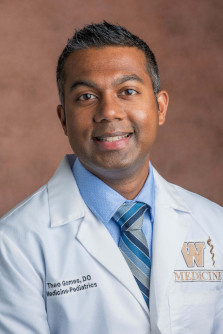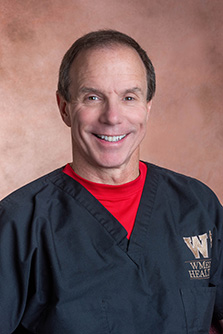
Program Director
Welcome from the Program Director
Welcome to the Medicine-Pediatrics Residency Program! I started my clinical training in the Medicine-Pediatrics Residency right here in Kalamazoo, Michigan, becoming chief resident in my final year of training, accepting a faculty appointment and eventually taking on the position of Program Director. It has been an honor to serve within the Kalamazoo community since 2013. WMed has always had a strong sense of dedication toward medical education at all different levels with a focus on multidisciplinary and patient centered care. There has been an increasing focus on primary care wellness with an engagement in quality improvement and scholarly activity.
With a thriving medical school containing a state-of-the-art facility and an expansive simulation center, there is ample opportunity for both faculty and residents to be involved in medical student education and simulation-based practice. In addition to my clinical responsibilities I also serve as a course director in the undergraduate medical education curriculum where residents receive the opportunity to be involved as academic instructors beyond working with medical students in the clinical setting.
There is a tremendous amount of support and collaboration in both osteopathic as well as allopathic medicine. Aside from my role as program director, I also serve as the Medical Director of Osteopathic Education for the Medicine-Pediatrics residency. Our Medicine-Pediatrics residency is one of the few programs distinguished to have National Osteopathic Recognition and have a core dedicated faculty for continuing osteopathic medical education welcoming both MDs and DOs alike in hands-on instruction in the principles of manual medicine.
Our commitment to education is paramount with a rich emphasis on weekly didactics, the opportunity to perform quality improvement projects, and scholarly activity. We feature a multi-departmental global health track with experiences to sharpen the skills needed to meet the complex demands of healthcare in resource limited settings and the ability to participate in away rotations including Alaska, Madagascar and Peru.
I decided to stay in Kalamazoo, because I truly feel it is a gem among programs. It is a place where close lasting relationships are built that stand at the core beliefs of the institution. Each year, our graduates accept positions in competitive fellowships, rural and urban primary care, global health and hospital and academic medicine.
It truly is an exciting time to be a Medicine-Pediatrics physician! We hope you will join us in taking the next step in your career by seeing all we have to offer!

Associate Program Director
Message from the Associate Program Director
I fell in love with Med-Peds as a specialty from the moment I heard about it. I wanted the depth of training that pediatricians and internists have without having to give up either patient population. It provides excellent training in the care of children and adults in a wide variety of settings as divergent as outpatient practice, critical care and international and resource limited locations. It is the most versatile residency program available in the United States. Graduates can pursue primary and acute inpatient care in countless different arrangements and any of 33 different pediatric or internal medicine subspecialties, and another 10 combined Med-Peds subspecialties.
I came to WMed in 1994 long before the school existed and was the founding director of the Med-Peds residency program as part of Michigan State University Kalamazoo Center for Medical Studies. It was the outstanding faculty and staff and their dedication to medical education that first drew me to Kalamazoo. Over the years the name and affiliation have changed but the faculty’s commitment to training exemplary residents remains. The medical school’s state-of-the-art Simulation Center and institutional culture fostering creativity in education has allowed for the development of multiple curricula and research opportunities that would directly impact you: The Foundations of Clinical Medicine course for our new interns, including bedside procedures; the point-of-care ultrasound course, the global health track; our international rotations and scholarly activity on a wide variety of projects from tropical medicine to Med-Peds training. Each year, our graduates enter outstanding inpatient and outpatient practices and match into their top choices in fellowship programs around the country. Finally, I am excited that we have realized my dream of over 25 years - nestling our combined Med-Peds clinic together with our categorical Internal Medicine and Pediatrics clinics all on the same floor. This allows for an improved synergy of ideas and teaching between all three specialties to best utilize all the resources of the WMed medical home to better serve our vulnerable patient population.
Program Highlights
- A combined Medicine-Pediatrics clinic
- Well-integrated curriculum with easy transitions between the categorical Internal Medicine and Pediatrics programs
- Global health/international and tropical medicine curriculum with WMed Global Health certificate
- Combined-trained program director, associate program director, and faculty
- National Osteopathic Recognition with ACGME accreditation for Med-Peds curriculum
- Board eligibility in both specialties
- Dedicated program coordinator and administrative assistant
- Fellowship matches in competitive fields such as cardiology, pulmonary/critical care, allergy/immunology, and infectious disease to name a few
FAQs
- In which hospitals do residents work?
Our residents rotate through two teaching health systems, Beacon Health System and Bronson Healthcare. Beacon Kalamazoo is a 422-bed tertiary care facility with a Level 2 trauma center, over 60,000 ER visits yearly, and an inpatient psychiatry unit. Bronson Methodist Hospital is a 410-bed tertiary care hospital with a Level 1 trauma center, over 99,000 ER visits yearly, and an inpatient Children’s Hospital with 35,000 children treated annually. Bronson Children’s Hospital includes a general pediatric service, PICU, and a Level 3 NICU and nursery.
- What is the patient population like?
Kalamazoo has a broad and varied patient population that needs primary care and hospital care. We care for patients throughout the region, including a significant number of university/hospital employees and their families. Our facility provides 24/7 interpreter services to support patient care. We serve patients across the economic spectrum, including those with limited financial resources. There is a wide variety of disease processes and pathology from which to learn.
- Are there international electives?
Yes! WMed has a global health certificate track. The faculty schedule annual trips to Peru and work with residents to achieve this certificate. Residents earn certification by completing a curriculum which includes global health grand rounds presented by internationally renowned speakers, experiential hands-on learning in WMed faculty-approved sites such as Peru, as well as infectious disease/tropical medicine online modules that can be completed at your own pace and convenience. We also utilize our novel point-of-care ultrasound (a yearlong flipped classroom certification course available to all trainees) in the jungles of Peru to provide real-time bedside diagnostic imaging.
- Do residents have opportunities to do scholarly activity?
Yes! Residents learn about quality improvement and are paired to do QI projects. The program also has a repository of research opportunities that can pair residents with WMED and community faculty research interests.
- How successful are Med-Peds residents with fellowship matches?
Our residents are successful in matching in their top choices of categorical and combined sub-specialties including cardiology, infectious disease, pulmonary, pulmonary/critical care, allergy-immunology, sleep medicine, palliative care, and transitional care.
- Can residents be part of hospital committees or develop leadership skills?
Yes, residents and fellows have opportunities to participate as full members of important system-wide committees such as: Safety, Resident/Fellow Quality and Safety Council, Clinical Excellence, Graduate Medical Education (GME) and many more.
- Are residents supported by appropriate ancillary staff?
Yes! Ancillary support staff are critical to the infrastructure of both hospitals and the WMed Health clinics. In both hospitals we have EKG technicians, respiratory therapists, phlebotomy, ultrasound/echo technicians, EEG technicians, blood gas and patient escort teams, music therapy as well as therapy dogs!
- Do the residents have a combined Med-Peds clinic?
Yes! We have an internal medicine-pediatrics resident continuity clinic that is staffed by our full-time Med-Peds clinic faculty in conjunction with IM and Peds faculty. There is a true emphasis on Medicine-Pediatrics as our categorical IM and Peds clinic sit side by side with one another. Our residents have a half day of clinic once a week. Our clinic is well organized and well run. During a clinic day, we see approximately 50/50 pediatric and medicine patients. We have a unique clinic structure where residents have split time slots in Internal Medicine and in Pediatrics during the same continuity day. For those interested in OMM, we also have clinic on specified half days per week that is staffed by our osteopathic faculty.
- Do you have a night float system?
Pediatrics: Pediatric call is usually 5-10 nights per four-week block when on a core service. The average is probably closer to five and there are two to four weekend shifts when on electives.
Medicine: Medicine call is usually four nights per four-week block when on a core service. There are two to four weekend shifts when on electives.
- Are there employment opportunities for my spouse in Kalamazoo?
Absolutely! Kalamazoo is a thriving business community with exceptional career opportunities in banking, law, education, pharmaceuticals, biotechnology, retail, hospitality and, of course, health care. The area is home to Pfizer and the global headquarters for Stryker.
- What is your program's board pass rate for pediatrics and internal medicine?
For the last three years, our program has been near or above the national average.

